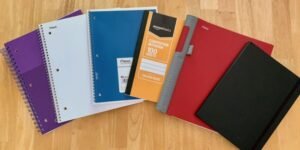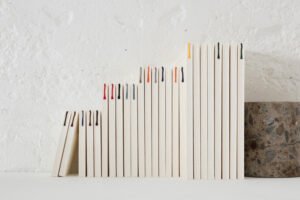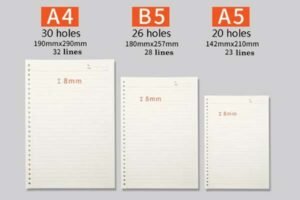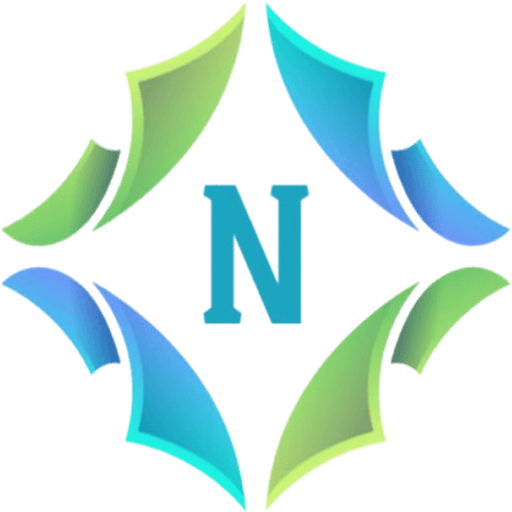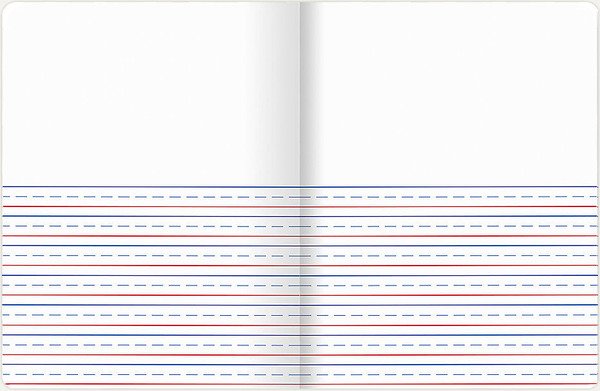
Do you ever get confused by notebook terms? Maybe you've heard "primary notebook" and wondered what it is. I'm here to explain it simply for you.
A primary notebook1 is a special notebook for young children learning to write. It has specific lined paper with a top line, a dotted middle line, and a bottom line to guide letter formation.
These notebooks are designed to help kids practice their handwriting. The lines show them where to start and end their letters. They also help with the size and spacing of letters. Think of it as a training tool for neat writing. Early grade teachers often use these to teach basic penmanship skills. It makes learning to write much easier and clearer for young students who are just starting their educational journey.
Primary notebooks usually have paper that is strong enough for lots of erasing, which kids often do. The ruling is often wider than standard notebooks. This gives more space for larger, developing handwriting. Some primary notebooks might also include a space at the top of each page for drawing pictures related to what they write. This helps combine writing and creative expression.
What is a Bound Notebook?

Now that we understand primary notebooks, what about "bound" notebooks? The term "bound" refers to how the pages are held together. Let's look at what that means.
A bound notebook2 is one where the pages are permanently attached together at the spine. This is usually done through methods like sewing or gluing, keeping your notes secure and organized.
When we talk about a bound notebook, we mean the pages aren't loose or easily removable like in a ring binder or a spiral notebook. The binding method can really affect how the notebook feels, how long it lasts, and how it performs in daily use. Let's dive deeper into the common types of binding.
Common Types of Bound Notebooks
There are several ways to bind a notebook. Each has its own features and benefits.
1. Sewn Binding
This is a very traditional and durable method.
- How it works: Pages are arranged in small groups called signatures. These signatures are then literally sewn together along the spine. The entire block of sewn pages can then be attached to the cover.
- Pros: Extremely strong and long-lasting. Notebooks with sewn binding3 can often lay flat when open, making them easier to write in. This is great for journals or notebooks you want to keep for a long time. As a manufacturer, we've produced beautiful FSC-certified plant atlas notebooks for a German chain bookstore using a bare spine sewn binding. This specific technique allows the notebook to lay completely 180° flat.
- Cons: It can be more expensive and time-consuming to produce compared to other methods.
2. Perfect Binding (Glue Binding)
You see this type of binding very often, especially with paperback books.
- How it works: The edges of all the pages are aligned to form a block. Then, a strong, flexible adhesive is applied to the spine to hold them all together with the cover.
- Pros: It’s a cost-effective method, especially for large quantities. It gives a neat, flat spine that looks professional. We can also do "sewing glue binding," which combines sewing signatures first and then gluing them into a cover for added strength.
- Cons: Notebooks with only glue binding might not lay perfectly flat. With very heavy use, pages could sometimes come loose, though modern adhesives are very strong. The thickness can also be a factor; for example, one of our clients, a Japanese stationery brand, found that ordinary glue binding couldn't achieve the ultra-thin profile they needed for a weekly planner with over 200 pages, pushing us to explore specific solutions for them.
3. Case Binding (Hardcover)
This is what you typically find on hardcover books and premium notebooks.
- How it works: The inside pages are often sewn together into a block (similar to sewn binding). This block is then glued into a rigid cover made of cardboard wrapped in paper, cloth, or another material.
- Pros: This is the most durable type of binding. It offers excellent protection for the pages and has a very high-quality feel.
- Cons: It's usually the most expensive option and can make the notebook bulkier and heavier.
Which Bound Notebook is Right for You?
Choosing the right binding depends on your needs.
- For durability and frequent use: Sewn binding or case binding are excellent choices.
- For laying flat: Sewn binding, especially techniques like bare spine sewing, is best.
- For budget-friendly options in large quantities: Perfect binding can be a good solution.
- For a premium feel and maximum protection: Case binding is the way to go.
Here's a quick comparison:
| Binding Type | Durability Level | Lay-Flat Ability | Typical Cost | Best For |
|---|---|---|---|---|
| Sewn Binding | High | Good to Excellent | Moderate-High | Journals, archival notebooks, lab books |
| Perfect Binding | Moderate | Fair | Low-Moderate | Paperback books, manuals, some notebooks |
| Case Binding | Very High | Good | High | Textbooks, premium journals, reference books |
At NotebookRing®, we have a lot of experience with these binding methods. We work with our clients to choose the best option for their specific product, whether it's a batch of school notebooks or a high-end corporate gift. For instance, we have specialized in sewing glue binding, which offers a great balance of durability and the ability for notebooks to lay relatively flat.
Thinking about primary notebooks for your students, or perhaps some beautifully bound journals for your brand? At NotebookRing®, we produce both these types and many more. We can customize primary notebooks to meet specific educational standards, like those for EU eco-labels with bilingual printing. We also excel in creating custom bound notebooks – from FSC-certified atlas series with 180° lay-flat sewn binding for bookstores, to sophisticated business sets for corporate clients. Our expertise in processes like hot stamping, laser engraving, and using a variety of paper types allows us to create the perfect notebook for you.
Conclusion
So, primary notebooks help young learners master writing with guided lines. Bound notebooks use methods like sewing or gluing to keep pages secure. Knowing this helps you pick the perfect notebook for any need.
-
Explore this link to understand how primary notebooks aid children's handwriting development and learning. ↩
-
Discover the various types of bound notebooks and their unique features to find the best fit for your needs. ↩
-
Learn about the advantages of sewn binding, including durability and lay-flat capabilities, for your notebook choices. ↩

